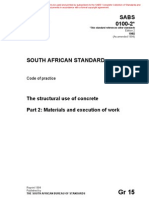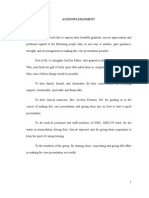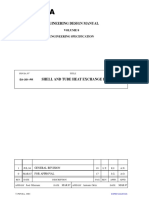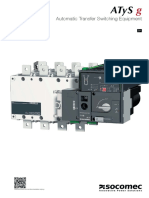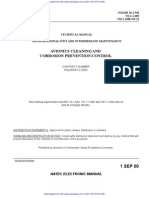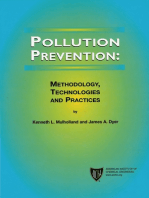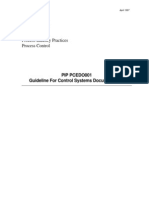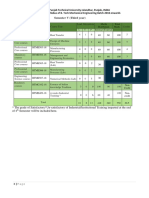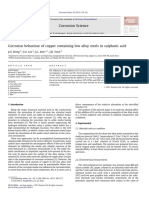Ae 211 PDF
Ae 211 PDF
Uploaded by
Nestor GalianoCopyright:
Available Formats
Ae 211 PDF
Ae 211 PDF
Uploaded by
Nestor GalianoOriginal Title
Copyright
Available Formats
Share this document
Did you find this document useful?
Is this content inappropriate?
Copyright:
Available Formats
Ae 211 PDF
Ae 211 PDF
Uploaded by
Nestor GalianoCopyright:
Available Formats
PDVSA
ENGINEERING DESIGN MANUAL
VOLUME 18II
ENGINEERING SPECIFICATION
PDVSA N
TITLE
ROADS ASPHALTIC CONCRETE
AE211
NOV.92
GENERAL REVISION
NOV.85
FOR APPROVAL
REV.
DATE
APPD.BY Jos Gilarranz
E PDVSA, 1983
14
DESCRIPTION
DATE
L.T.
R.P.
R.R.
J.S.
J.G.
E.S.
APPD.
APPD.
PAG. REV.
NOV.85 APPD.BY Eduardo Santamaria
DATE
NOV.85
ESPECIALISTAS
ENGINEERING SPECIFICATION
PDVSA
ROADS ASPHALTIC CONCRETE
PDVSA AE211
REVISION
FECHA
NOV.92
Pgina 1
.Men Principal
Indice manual
Indice volumen
Indice norma
Index
1 GENERAL . . . . . . . . . . . . . . . . . . . . . . . . . . . . . . . . . . . . . . . . . . . . . . . . .
1.1
1.2
1.3
1.4
1.5
1.6
1.7
1.8
1.9
1.10
1.11
Work Included . . . . . . . . . . . . . . . . . . . . . . . . . . . . . . . . . . . . . . . . . . . . . . . . . .
PDVSA References . . . . . . . . . . . . . . . . . . . . . . . . . . . . . . . . . . . . . . . . . . . . .
System Description and Definitions . . . . . . . . . . . . . . . . . . . . . . . . . . . . . . . .
Testing Agency . . . . . . . . . . . . . . . . . . . . . . . . . . . . . . . . . . . . . . . . . . . . . . . . .
Regulatory Requirements . . . . . . . . . . . . . . . . . . . . . . . . . . . . . . . . . . . . . . . .
References . . . . . . . . . . . . . . . . . . . . . . . . . . . . . . . . . . . . . . . . . . . . . . . . . . . . .
Records and Files . . . . . . . . . . . . . . . . . . . . . . . . . . . . . . . . . . . . . . . . . . . . . . .
Delivery . . . . . . . . . . . . . . . . . . . . . . . . . . . . . . . . . . . . . . . . . . . . . . . . . . . . . . . .
Site Conditions . . . . . . . . . . . . . . . . . . . . . . . . . . . . . . . . . . . . . . . . . . . . . . . . . .
Atmospherie Conditions . . . . . . . . . . . . . . . . . . . . . . . . . . . . . . . . . . . . . . . . . .
Guarantee . . . . . . . . . . . . . . . . . . . . . . . . . . . . . . . . . . . . . . . . . . . . . . . . . . . . . .
2
2
2
2
2
3
4
4
4
4
4
2 MATERIALS . . . . . . . . . . . . . . . . . . . . . . . . . . . . . . . . . . . . . . . . . . . . . . . .
2.1
2.2
2.3
2.4
2.5
2.6
2.7
2.8
2.9
Unnaceptable Soil Materials . . . . . . . . . . . . . . . . . . . . . . . . . . . . . . . . . . . . . .
Subgrade Fill Material . . . . . . . . . . . . . . . . . . . . . . . . . . . . . . . . . . . . . . . . . . .
Subbase Material . . . . . . . . . . . . . . . . . . . . . . . . . . . . . . . . . . . . . . . . . . . . . . .
Base Course . . . . . . . . . . . . . . . . . . . . . . . . . . . . . . . . . . . . . . . . . . . . . . . . . . .
Asphalt Paving . . . . . . . . . . . . . . . . . . . . . . . . . . . . . . . . . . . . . . . . . . . . . . . . . .
Prime Coat . . . . . . . . . . . . . . . . . . . . . . . . . . . . . . . . . . . . . . . . . . . . . . . . . . . . .
Tack Coat . . . . . . . . . . . . . . . . . . . . . . . . . . . . . . . . . . . . . . . . . . . . . . . . . . . . . .
Shoulders . . . . . . . . . . . . . . . . . . . . . . . . . . . . . . . . . . . . . . . . . . . . . . . . . . . . . .
Mixes . . . . . . . . . . . . . . . . . . . . . . . . . . . . . . . . . . . . . . . . . . . . . . . . . . . . . . . . .
4
5
5
5
5
6
6
6
6
3 EXECUTION . . . . . . . . . . . . . . . . . . . . . . . . . . . . . . . . . . . . . . . . . . . . . . .
3.1
3.2
3.3
3.4
3.5
3.6
3.7
3.8
3.9
3.10
3.11
3.12
3.13
Road Alignment . . . . . . . . . . . . . . . . . . . . . . . . . . . . . . . . . . . . . . . . . . . . . . . . .
Subgrade Preparation . . . . . . . . . . . . . . . . . . . . . . . . . . . . . . . . . . . . . . . . . . .
Subbase Course . . . . . . . . . . . . . . . . . . . . . . . . . . . . . . . . . . . . . . . . . . . . . . . .
Base Course . . . . . . . . . . . . . . . . . . . . . . . . . . . . . . . . . . . . . . . . . . . . . . . . . . .
Prime Coat . . . . . . . . . . . . . . . . . . . . . . . . . . . . . . . . . . . . . . . . . . . . . . . . . . . . .
Tack Coat . . . . . . . . . . . . . . . . . . . . . . . . . . . . . . . . . . . . . . . . . . . . . . . . . . . . . .
Reconditioning the Base Course . . . . . . . . . . . . . . . . . . . . . . . . . . . . . . . . . .
Surface Course . . . . . . . . . . . . . . . . . . . . . . . . . . . . . . . . . . . . . . . . . . . . . . . . .
Shoulders . . . . . . . . . . . . . . . . . . . . . . . . . . . . . . . . . . . . . . . . . . . . . . . . . . . . . .
Tolerances . . . . . . . . . . . . . . . . . . . . . . . . . . . . . . . . . . . . . . . . . . . . . . . . . . . . .
Field Test and Quality Requirements . . . . . . . . . . . . . . . . . . . . . . . . . . . . . . .
Protection . . . . . . . . . . . . . . . . . . . . . . . . . . . . . . . . . . . . . . . . . . . . . . . . . . . . . .
Cleaning . . . . . . . . . . . . . . . . . . . . . . . . . . . . . . . . . . . . . . . . . . . . . . . . . . . . . . .
6
6
7
7
8
8
8
9
11
12
12
12
13
ENGINEERING SPECIFICATION
PDVSA
PDVSA AE211
ROADS ASPHALTIC CONCRETE
REVISION
FECHA
NOV.92
Pgina 2
.Men Principal
Indice manual
Indice volumen
Indice norma
GENERAL
1.1
Work Included
Subgrade Preparation
Subbase
Base and Prime Coat
Asphalt Surface Course
Shoulders
Mix
1.2
PDVSA References
Culverts
Earthwork Excavation and Backfill
Site Clearance and General Earthwork
Site Data
1.3
AL211PRT
AK211
AI211
SD251
System Description and Definitions
1.3.1
Roads used for construction traffic shall not receive a surface course or curbs until
heavy construction traffic has finished using the road. Apply a prime coat to the
base course before using road for construction traffic.
1.3.2
For dimensions, locations, road cross sections, and geometry, see PDVSAs
drawing and standard data sheets.
1.3.3
The following are definitions of terms as used in this specification:
Subgrade
Subbase
1.4
The roadbed soils up to plant rough grade. Subgrade may be
achieved by cutting, filling or grading.
The layer(s) of specified or selected material placed on the
subgrade to support a base course.
See Covenin N 2000 Parte I, VPavimentos (AASHTO N
GDPS3) for definition of terms used in this specification other
than the above.
Testing Agency
All Required testing shall be contracted and arranged directly by PDVSA. Tests
shall include sampling and testing of the asphalt concrete mixture at the mix plant
and from the material delivered to the site.
1.5
1.5.1
Regulatory Requirements
Comply with all applicable Venezuelan laws, standards, and regulations.
ENGINEERING SPECIFICATION
PDVSA
ROADS ASPHALTIC CONCRETE
PDVSA AE211
REVISION
FECHA
NOV.92
Pgina 3
.Men Principal
Indice manual
Indice volumen
Indice norma
1.5.2
Pavimentos MOP 1962.
1.5.3
Covenin Provisional 2000 Parte II Carreteras C12 Pavimentos Asflticos.
1.5.4
Especificaciones para la Construccin de Pavimentos de Carreteras MOP
1956.
1.6
1.6.1
1.6.2
1.6.3
References
AASHTO American Association of State Highway and Transportation
Officials
M145
The Classification of Soils and SoilAggregate Mixtures for
Highway Construction Purposes.
M226
Viscosity Graded Asphalt Cement
T166
Bulk Specific Gravity of Compacted Bituminous Mixtures
GDPS3
Interm Guide for Design of Pavement Structures
Asphalt Institute
MS2
Mix Design Methods for Asphalt Concrete and other Hotmix
types
MS8
Asphalt Paving Manual
ASTM American Society for Testing and Materials
C131
Standard Test Method for Resistance to Degradation of Small
Size Course Aggregate by Abrasion and Impact in Los Angeles
Machine
D242
Mixtures
Standard Specification for Mineral Filler for Bituminous Paving
D692
Standard Specification for Course Aggregate for Bituminous
Paving Mixtures
D698
Standard Test Method of Moisture Density Relations of Soils
and Soil Aggregate Mixtures Using 5.5 lbs (2.49 kg) Rammer
and 12 in (305mm) Drop
D977
Standard Specification for Emulsified Asphalt
D995
Standard Specification for Requirements for Mixing Plants for
HotMixed HotLaid Bituminous Paving Mixtures
D1073
Standard Specification for Fine Aggregate for Bituminous
Paving Mixtures
D1559
Standard Test Methods for Resistances to Plastic Flow of
Bituminous Mixtures Using Marshall Apparatus
ENGINEERING SPECIFICATION
PDVSA
ROADS ASPHALTIC CONCRETE
PDVSA AE211
REVISION
FECHA
NOV.92
Pgina 4
.Men Principal
D2027
Indice manual
Indice volumen
Indice norma
Standard Specification for Cutback Asphalt (Medium Curing
Type)
D2419
Standard Test methods for Sand Equivalent Value of Soils and
Fine Aggregate
1.6.4
1.7
D2487
Purposes
Standard Test methods for Classification of Soil for Engineering
D3515
Standard Specification for HoMixed, HotLaid Bituminous
Paving Materials
All latest edition codes, standards and specifications, including applicable
addenda shall form part of this specification to the extent specified herein.
Records and Files
Contractor shall open and keep orderly chronological files of all tests results and
reports related to the works. All information shall be available and accessible to
Owner at any desired moment. Contractor is responsible in case serious
incoherence of information from third parties is found, is obliged.
1.8
Delivery
Transport asphalt concrete mixtures to project site in trucks having tight, clean
compartments. Provide covers over mixture to protect it and reduce loss of heat.
1.9
Site Conditions
1.9.1
See Specification Site Data, PDVSA SD251 for general physical conditions.
1.9.2
Geotechnical Report including boring logs and test data to determine soil and
water condition:
1.10
Atmospheric Conditions
Application and priming shall be performed according to COVENIN 2000 Parte II
and PDVSA SD251.
1.11
Guarantee
Contractor shall guarantee in writing the satisfactory performance of the complete
pavement for a period for a period defined in each particular contract. All repairs
to roads during the guarantee period shall be the sole expense of the Contractor.
MATERIALS
2.1
Unacceptable Soil Materials
Clay, shale, and materials showing undesirable disintegration.
ENGINEERING SPECIFICATION
PDVSA
ROADS ASPHALTIC CONCRETE
PDVSA AE211
REVISION
FECHA
NOV.92
Pgina 5
.Men Principal
2.2
Indice manual
Indice volumen
Indice norma
Subgrade Fill Material
Granular soils conforming Covenin 200080 Parte II (to group classifications A1,
A2 or A3 in accordance with AASHTO M145). The material shall contain no
organic matter, debris, or particle size greater than 100 mm in any dimension.
2.3
Subbase Material
Natural Soil The same as material specified as subgrade fill materials, except
that it shall contain no particle size greater than 50mm in an dimension. Material
shall have a CBR value greater than 40.
2.4
2.4.1
Base Course
Aggregate
Well graded gravels or crushed and screened rock containing at least 50%, by
weight, of crushed particles. Material shall be free from excessive amount of thin,
elongated particles.
2.4.2
Gradation shall conform to Covenin 2000 Parte II
2.4.3
Additional Requirement
CBR Value
Maximum % of Wear:
Plasticity Index::
2.5
Greater than 80
50% Covenin 2000 Parte II (ASTM 131)
PI = 0
Asphalt Paving
2.5.1
Bituminous Materials Asphalt complying with requirements of AASHTO M226.
Submit recommended material to PDVSA for approval before construction.
2.5.2
Mineral Aggregates Crushed stone, gravel, sharpedge natural sand, mineral
filler, or a combination of two or more of these materials. Aggregates shall meet
the requirements of the following specifications.
Coarse Aggregates
ASTM D693
Fine Aggregates
ASTM D1073
Mineral Filler
Limestone or dolomite dust and portland cement
with 80% passing 0,075 mm (N 200) sieve
ASTM D242
The combined aggregate (after drying) shall have a sand equivalent not less than
45% as determined by ASTM D2419.
2.5.3
Total pavement thickness shall be 50 mm with the maximum aggregate size of 25
mm.
ENGINEERING SPECIFICATION
PDVSA
ROADS ASPHALTIC CONCRETE
PDVSA AE211
REVISION
FECHA
NOV.92
Pgina 6
.Men Principal
2.6
Indice manual
Indice volumen
Indice norma
Prime Coat
Cutback Asphalt MC70 conforming to the requirements of Covenin 2000 Parte
II (ASTM D2027).
2.7
Tack Coat
Asphalt base uniformly emulsified with water and emulsifying or stabilizing agent
complying with the requirements of ASTM D977, as follows:
Grades SS1 or SS1h
2.8
Shoulders
Materials conforming to subbase and base materials with maximum aggregate
size of 75 mm in any dimension.
2.9
Mixes
2.9.1
Mixing plant conform to requirements of Covenin 2000 Parte II, (ASTM D995).
2.9.2
AsphaltAggregate Mixture The job mix formula for the surface course shall be
within the limits for dense mixtures as indicated in Covenin 2000 Parte II, (ASTM
D3515).
2.9.3
The asphalt aggregate mixture shall be prepared and tested in accordance with
Covenin 2000 Parte II, (ASTM D3515).
2.9.4
A mix specified by a local agency shall be considered if it has been shown to have
a satisfactory history of performance.
2.9.5
Contractor shall submit the job mix formula to PDVSA for approval before starting
the work.
EXECUTION
3.1
Road Alignment
3.1.1
A minimum of two permanent benchmarks will be furnished by PDVSA.
3.1.2
Contractor shall establish the necessary road center line and grade stakes
needed to accomplish the work.
3.1.3
Preserve all Contractorplaced benchmarks and stakes for verification and use
by others.
3.2
3.2.1
Subgrade Preparation
The subgrade consist of all soil up to plant rough grade elevation as shown on the
drawings and established in accordance with Specification Site Clearance and
ENGINEERING SPECIFICATION
PDVSA
ROADS ASPHALTIC CONCRETE
PDVSA AE211
REVISION
FECHA
NOV.92
Pgina 7
.Men Principal
Indice manual
Indice volumen
Indice norma
General Earthwork, PDVSA AI211. If required, excavate the existing plant
rough grade to install the full thickness of the pavement.
3.2.2
Excavate the following to the required depths and replace with subgrade fill
material.
Soft Spots Remove soft and unstable materials which cannot be compacted to
the required density. Remove to a minimum depth of 600 mm below the subgrade
elevation.
Rock Cut isolated large boulders and rocks to a minimum of 150 mm below the
subgrade surface.
3.2.3
Prevent surface water from flowing into and accumulating in excavated areas.
3.2.4
Compact the subgrade out to the edges of permanent ditches or to 300 mm
beyond the edge of the shoulder, whichever is greater. Compact a minimum of
300 mm in depth to 95% of the maximum density at optimum moisture content by
the test in specification ASTM D698 (Standard Proctor).
3.3
Subbase Course
3.3.1
Placing subbase material
Remove trash and debris from subgrade before placing subbase material.
Deposit and spread subbase material upon the approved subgrade in uniform,
nearly horizontal layers, without segregation of size, to such loose depth that,
when compacted, the total course will have the required thickness shown on
PDVSAs drawings.
Do not place in layers thicker than 200 mm.
If thicker layer is desired, submit proposed layer thickness, equipment, and
procedures of construction in writing to PDVSA for approval. However, maximum
allowable layer thickness is 450 mm.
3.3.2
Compact each layer for the full width and depth by rolling with approved
compacting equipment. Use alternate blading and rolling to obtain a smooth,
even, and uniformly compacted course.
Use powerdriven hand tampers for compacting backfill adjacent to structures.
Compact road gravel and screenings to not less than 95% of maximum density
at optimum moisture content as determined by Covenin 2000 Parte II (MOP
Ensayo E122) (ASTM D1557).
3.3.3
Construct subbase drainage as shown on drawings. The drainage system may
be constructed of the same material used for the subbase.
3.4
3.4.1
Base Course
Deposit and spread the base course material on the completed and approved
subbase in uniform, nearly horizontal layers, without segregation of size, to such
ENGINEERING SPECIFICATION
PDVSA
ROADS ASPHALTIC CONCRETE
PDVSA AE211
REVISION
FECHA
NOV.92
Pgina 8
.Men Principal
Indice manual
Indice volumen
Indice norma
loose depth that when compacted, the total course will have the required
thickness.
3.4.2
Extend the edge of the base course a minimum of 300 mm beyond the edge of
the shoulder.
3.4.3
Compact each layer for the full width and depth by rolling with approved
compacting equipment. Alternately blade and roll to obtain a smooth, even, and
uniformly compacted course.
3.4.4
Compact road gravel and screenings to a density not less than 95% of maximum
density at optimum moisture content as determined by Covenin 2000 Parte II
(MOPEnsayo E122) (ASTM D1557).
3.4.5
Compact the final surface with a smooth wheel powered roller to obtain a firm and
smooth surface finish that is true to the established grade.
3.5
Prime Coat
3.5.1
Remove all loose material from compacted base surface before applying prime
coat.
3.5.2
Uniformly apply the prime coat, distributed at the rate of 0,9 to 2,3 liters/m2, over
the compacted base course. Apply sufficient material to penetrate and seal, but
do not flood the surface. Allow to cure and dry as long as required to attain
penetration and evaporation of the volatiles, but in no case less than 48 hours
unless otherwise accepted by PDVSA.
3.6
Tack Coat
3.6.1
Uniformly apply the tack coat to joints and between asphalt layers. Distribute at
the rate of 0,5 to 0,7 liters/m2 over the surface.
3.6.2
Apply tack coat by brush to contact surfaces of curbs, gutters, manholes, and
other structures projecting into or abutting asphalt concrete pavement.
3.6.3
Allow surfaces to dry until tack coat material is at proper condition of tackiness to
receive the asphalt concrete mixture.
3.7
Reconditioning the Base Course
3.7.1
Recondition base course that has been disturbed by construction operations.
3.7.2
Scarify the surface, reshape to the required line and grade, add material where
required, and compact to the required density.
3.7.3
Proof roll the compacted surface to check for unstable areas requiring additional
compaction.
ENGINEERING SPECIFICATION
PDVSA
ROADS ASPHALTIC CONCRETE
PDVSA AE211
REVISION
FECHA
NOV.92
Pgina 9
.Men Principal
3.7.4
3.8
Indice manual
Indice volumen
Indice norma
Where the primed base course has been disturbed by construction operations,
thoroughly clean surfaces of debris and dirt, reshape, and repair the surface.
Surface Course
3.8.1
General The surface course shall consist of a one or twolayer of a hot laid, plant
mixed asphaltic concrete placed on the primed base course. The tack coat is
applied between layers.
3.8.2
Placing the Mix
General Place the asphalt concrete mixture on the prepared surface, spread,
and strikeoff using an acceptable bituminous paver. Spread mixture at minimum
temperature 107 C. Inaccessible and small areas may be placed by hand. Place
each course in the required amounts so they will conform to the indicated grade,
crosssection, and thickness when compacted.
Paver Placing Unless otherwise directed, begin placing along the centerline of
areas to be paved on a crowned section, at the high side of sections with a
oneway slope, and in the direction of traffic flow.
Place in strips not less than 3000 mm wide, unless otherwise acceptable to
PDVSA. After the first strip has been placed and rolled, place all succeeding strips
and extend rolling to overlap previous strips. Complete binder course for a section
before placing any wearing course materials. Place mixture in as continuous an
operation as possible.
Hand Placing Spread, tamp, and finish the mixture using hand tools in areas
where the use of machine spreading is not possible. Place mixture at a rate that
will ensure proper handling and compaction before the mixture becomes cooler
than acceptable working temperature.
ENGINEERING SPECIFICATION
PDVSA
ROADS ASPHALTIC CONCRETE
PDVSA AE211
REVISION
FECHA
NOV.92
Pgina 10
.Men Principal
3.8.3
Indice manual
Indice volumen
Indice norma
Joints
Carefully make joints between old any new pavements, or between successive
days work, to ensure a continuous bond between adjoining work. Joints shall
have the same texture, density, and smoothness as other sections of the asphalt
concrete course.
Clean contact surfaces of sand, dirt, or other objectionable material. Apply tack
coat.
Offset transverse joints in succeeding courses not less than 600 mm. Cut back
the edge of the previously placed course to expose an even, vertical surface for
the full course thickness.
Offset longitudinal joints in succeeding course not less than 150 mm. Cut back
the edge of the previously placed course to expose an even, vertical surface for
the full course thickness.
3.8.4
Curbs
Place curbs over inplace and compacted pavement surfaces. Apply a light tack
coat unless pavement surface is still tacky and free from dust.
Place curb materials to the cross section shown on PDVSAs drawings, or if not
indicated, to local standard shapes using machine laying methods, unless
otherwise acceptable to PDVSA. Adjust rate of placement to ensure adequate
compaction of the mixture as it is placed.
If permitted by PDVSA, material may be placed by hand in wood or metal forms.
Tamp han placed materials and screed to a smooth finish. Remove forms as soon
as the material has cooled to air temperature.
3.8.5
Compaction
General Begin rolling operations as soon after placing when the mixture will bear
the weight of the roller without excessive displacement. Do not suddenly change
the line or direction or rollin.
Compact the mixture with hot hand tampers or vibrating plate compactors is all
areas inaccessible to rollers.
Do not permit heavy equipment, including rollers, to stand on the finished surface
before it has thoroughly cooled or set.
Procedure Start rolling longitudinally at the extreme lower side of sections and
proceed toward the center of the pavement. Roll to slightly different lengths on
alternate runs of the rollers. Do not roll center of sections firsts under any
circumstances.
Begin rolling with the drive wheel or roll nearest the paver, moving at a slow,
constant speed of not more than 8 Km/h for pneumatictired rollers and 5 Km/h
for steel wheeled rollers.
ENGINEERING SPECIFICATION
PDVSA
ROADS ASPHALTIC CONCRETE
PDVSA AE211
REVISION
FECHA
NOV.92
Pgina 11
.Men Principal
Indice manual
Indice volumen
Indice norma
Breakdown Rolling Accomplish the breakdown or initial rolling using a two wheel
steel roller immediately following the rolling of transverse and longitudinal joints
and the outside edge. Operate rollers as close as possible to paver without
causing displacement. Use staticweight tandem rollers weighing from 7 to 11
metric tons or vibratory tandem rollers weighing from 6 to 14 metric tons.
Check the crown, grade, and smoothness after the breakdown rolling. Repair
displaced areas by loosening at once with lutes or rakes and filling, if required, with
hot loose material before continuing rolling.
Second Rolling Use pneumatictired rollers for the second rolling. Follow the
breakdown rolling as soon as possible while the mixture is hot and in condition for
proper compaction.
Continue the second rolling for at least three complete coverages or until the
mixture has been throughly compacted.
Finish Rolling Either steelwheeled or pneumatictired rollers may be used for
the finish rolling. Perform finish rolling while mixture is still warm enough for
removal or roller marks. Continue rolling until all roller marks are eliminated and
the course has attained the required density.
3.8.6
Patching
Remove and replace mixtures that become mixed with foreign materials and all
defective areas. Cutout such areas and fill with fresh, hot asphalt concrete.
Compact by rolloing to the required surface density and smoothness.
Remove deficient areas for the full depth of the course. Cut sides perpendicular
and parallel to the direction of traffic with edges vertical. Apply a tack coat before
placing fresh asphalt concrete mixture.
3.9
3.9.1
Shoulders
Placing the Fill
Remove trash and debris from compacted subgrade before placing the fill.
Extend width of shoulder from the edges of pavement to the near edge of ditches.
Where side forms area used, place fill for the full width and depth of shoulder
outside of forms. After pavement courses are completed, remove the forms and
the complete shoulders to the edges of pavement.
Where side forms are not used, place fill in horizontal layers in conjunction with
the base course.
Do not place fill in horizontal layer more than 200 mm in loose thickness.
3.9.2
Compaction
ENGINEERING SPECIFICATION
PDVSA
ROADS ASPHALTIC CONCRETE
PDVSA AE211
REVISION
FECHA
NOV.92
Pgina 12
.Men Principal
Indice manual
Indice volumen
Indice norma
Compact shoulder and pavement simultaneously.
Compact each layer of fill to at least 90% of Standard Proctor dry density
according to 3.3.2 (ASTM D 698).
Use powerdriven hand tamper to compact fill adjacent to structures and at the
edge of drainage ditches.
3.10
Tolerances
3.10.1
The surfaces of the finished courses shall not deviate from the elevations and
lines shown on PDVSAs drawings by the following:
Subbase, base course, shoulders: "12 mm
Binder course: "6 mm
Wearing course: "4 mm
3.10.2
Inplace compacted thickness shall not deviate from the thickness shown on
PDVSAs drawings by the following:
Wearing course:" 6 mm
All other courses: "12 mm
3.11
Field Test and Quality Requirements
3.11.1
Base and Subbase make at least two density tests for each day of paving, one
at quarter point and one at threequarter point.
3.11.2
Surface Course
Laboratory compacted samples At each day of road construction, take two bulk
samples from trucks delivering mixtures to the job site at first quarter and third
quarter points. Each bulk sample shall be approximately 10 Kgs. Prepare three
specimens from each bulk sample and compact specimen with 35 compaction
blows in accordance with ASTM D1559. Obtain target density (average density
of the six laboratory prepared specimens) in accordance with AASHTO T166.
Field Compacted Samples As directed by PDVSA, core drill two field specimens
75 mm diameter at asphalt pavement which was constructed the same day.
Obtain the density of each specimen in accordance with AASHTO T166. PDVSA
may call for more coring as the field conditions require.
Subcontractor shall repair holes caused by core drilling.
Acceptance average density of the two core drilled samples shall be at least
97%, and the individual core density shall not be less than 95% against the target
density of the same asphalt concrete mixture.
3.12
3.12.1
Protection
Protect newly placed material from traffic by barricades or other suitable method
until the mixture has colled and attained its maximum degree of hardness.
ENGINEERING SPECIFICATION
PDVSA
ROADS ASPHALTIC CONCRETE
PDVSA AE211
REVISION
FECHA
NOV.92
Pgina 13
.Men Principal
3.12.2
3.13
Indice manual
Indice volumen
Indice norma
After final rolling, do not permit vehicular traffic on the asphalt concrete pavement
until it has cooled and hardened, and in no case sooner than 6 hours.
Cleaning
Remove waste, trash, debris, fill material, and road materials from the site and
dispose in a legal manner. Contractor shall bear all costs connected with hauling
and dumpling these materials.
ENGINEERING SPECIFICATION
PDVSA
PDVSA AE211
ROADS ASPHALTIC CONCRETE
REVISION
FECHA
NOV.92
Pgina 14
.Men Principal
Indice manual
Indice volumen
Indice norma
1.APPENDIX 1
DESIGN DATA
DATA SHEET PLANT ROADS
Primary
Road
Secondary
Road
Access Way
Road width (min.)
(excluding shoulder)
7,50 m
6,00 m
3,0 m
Shoulders (min.)
1,2 m
1,0 m
Number of Lanes
Grade (max.) Plant roads
5%
5%
Grade (max.) Access roads
10%
10%
Crown Slopes
2%
2%
Shoulder Slope (min.)
4%
4%
Radius at Curve (to the nearside of the road)
7,5 m
6,00 m
Traffic Loading
MS18
MS18
Base thickness (min.)
300 mm
200 mm
Surface Course Thickness (min.)
50 mm
50 mm
100 mm
compacted
asphalt sand
Optional
Optional
Item
Thickness (min.)
Wearing Surface
Crown Elevation
3%
100 to 300 mm 100 to 300 mm 100 to 300 mm
Note: Thickness of each road structure course may be modified to satisfy the
requirements of geotechnical report and detailed design.
You might also like
- Ши Цу КуперDocument10 pagesШи Цу КуперDulce Celeste100% (3)
- L51PC Owner's Manual Leopard 51PCDocument228 pagesL51PC Owner's Manual Leopard 51PCf696npnqcqNo ratings yet
- Sans10100 2Document84 pagesSans10100 2matshona100% (16)
- Kaplan's Principles of Plant MorphologyDocument1,318 pagesKaplan's Principles of Plant MorphologyArchis LikhitkarNo ratings yet
- API IP 1594 - Nov 2002Document28 pagesAPI IP 1594 - Nov 2002FediMansouri100% (2)
- Tank Out of Plane Settlement PubDocument43 pagesTank Out of Plane Settlement PubNestor Galiano100% (3)
- Open Water Swimming Steven MunatonesDocument264 pagesOpen Water Swimming Steven MunatonesPhuc Hien100% (3)
- Astm D 3276 PDFDocument62 pagesAstm D 3276 PDFJose Luis CT100% (3)
- SANS1200AADocument10 pagesSANS1200AAHarrybfnNo ratings yet
- NZS 2295-2006 PDFDocument10 pagesNZS 2295-2006 PDFElmira Siroospour50% (2)
- API 614 ContentDocument7 pagesAPI 614 ContentD.Rameshkumar0% (1)
- Liver Cirrhosis Case PresentationDocument146 pagesLiver Cirrhosis Case Presentationjennachristy0395% (21)
- Pdvsa: Engineering Design ManualDocument11 pagesPdvsa: Engineering Design ManualDanny LopezNo ratings yet
- TM 5-805-14. Technical Manual. Roofing and WaterproofingDocument38 pagesTM 5-805-14. Technical Manual. Roofing and WaterproofingTitas Jegorovas100% (1)
- 600 - E13 PA PDFDocument3 pages600 - E13 PA PDFPasquale CutriNo ratings yet
- API Standard 600: Steel Gate Valves-Flanged and Butt-Welding Ends, Bolted BonnetsDocument3 pagesAPI Standard 600: Steel Gate Valves-Flanged and Butt-Welding Ends, Bolted BonnetsPasquale CutriNo ratings yet
- D-211 - Pressure Vessel Design and Fab SpecDocument17 pagesD-211 - Pressure Vessel Design and Fab SpecGidel RinconNo ratings yet
- PDVSA Am 211 PRTDocument10 pagesPDVSA Am 211 PRT75bm73No ratings yet
- Pdvsa: Engineering Design ManualDocument19 pagesPdvsa: Engineering Design ManualRafael GarciaNo ratings yet
- Ga-201 Centrif PumpsDocument31 pagesGa-201 Centrif PumpsCarlos Luis Esquerdo MarcanoNo ratings yet
- Ga 201Document31 pagesGa 201venezuelanNo ratings yet
- TM 9-1240-271-34&P - Periscope M118E1Document207 pagesTM 9-1240-271-34&P - Periscope M118E1Robert Kahler100% (1)
- API Specification 12B: Specification For Bolted Tanks For Storage of Production LiquidsDocument3 pagesAPI Specification 12B: Specification For Bolted Tanks For Storage of Production LiquidsArthamigas Ramdani100% (1)
- Pdvsa: Engineering Design ManualDocument10 pagesPdvsa: Engineering Design ManualElvina Sara Sucre BuenoNo ratings yet
- Nova Scotia Standards For Construction and Installation For Petroleum Storage Tank SystemsDocument84 pagesNova Scotia Standards For Construction and Installation For Petroleum Storage Tank SystemsMJ MagdyNo ratings yet
- Sec 3 ApapbDocument26 pagesSec 3 ApapbnikolicjelenaNo ratings yet
- TM422Document34 pagesTM422karamisin4274100% (1)
- 936 - E4 PA PDFDocument3 pages936 - E4 PA PDFtuxiboiNo ratings yet
- 96 E1 PA PDFDocument4 pages96 E1 PA PDFsanty222No ratings yet
- Facilities Engineering - Maint, Repair of Roof (US Army TM 5-617) (1974)Document126 pagesFacilities Engineering - Maint, Repair of Roof (US Army TM 5-617) (1974)Fernando Balseiro100% (1)
- API Stan Ndard RD 2R RD: Dynam Mic Ris Sers For Floatin NG Prod Duction System MsDocument3 pagesAPI Stan Ndard RD 2R RD: Dynam Mic Ris Sers For Floatin NG Prod Duction System MsMatheus Cipriano GoncalvesNo ratings yet
- Operations and Service Manual: Container RefrigerationDocument184 pagesOperations and Service Manual: Container RefrigerationEdwin Espinoza obandoNo ratings yet
- Pdvsa: Material Technical SpecificationDocument19 pagesPdvsa: Material Technical SpecificationRafael GarciaNo ratings yet
- LED Assembly (Simulation) InfoDocument22 pagesLED Assembly (Simulation) Infofangs997No ratings yet
- 1 01CH1Document4 pages1 01CH1HARINo ratings yet
- 14 June 99Document12 pages14 June 99Sigit BintanNo ratings yet
- Minimum Construction Requirement Water Bore-AUSDocument97 pagesMinimum Construction Requirement Water Bore-AUScysauts100% (1)
- TM 9-1220-231-34&P - Ballistic Drive M15Document105 pagesTM 9-1220-231-34&P - Ballistic Drive M15Robert Kahler100% (1)
- Mil STD 1808aDocument123 pagesMil STD 1808ascribd_drsNo ratings yet
- H 231Document18 pagesH 231EdirwinJoseChirinosNo ratings yet
- Rehau Raupiano TaekniupplysingarDocument40 pagesRehau Raupiano TaekniupplysingarNermin MNo ratings yet
- Transfer Switching Equipment 100, 200, 260, 400A: Instr Uction ManualDocument32 pagesTransfer Switching Equipment 100, 200, 260, 400A: Instr Uction ManualMesseňger HệŢhốngNo ratings yet
- Automatic Transfer Switching Equipment: Instr Uction ManualDocument68 pagesAutomatic Transfer Switching Equipment: Instr Uction ManualDaniel EneaNo ratings yet
- 06 Duct Design TOCDocument8 pages06 Duct Design TOCdjryleNo ratings yet
- Ag 211 PRT - Diques de TierraDocument8 pagesAg 211 PRT - Diques de TierraNOELY MARACARANo ratings yet
- Pavement DesignDocument56 pagesPavement DesignKitibwa Gitta100% (3)
- API Recommended Practice 1170: Design and Operation of Solution-Mined Salt Caverns Used For Natural Gas StorageDocument3 pagesAPI Recommended Practice 1170: Design and Operation of Solution-Mined Salt Caverns Used For Natural Gas Storageshahriar70No ratings yet
- A15 Controller Instruction ManualDocument38 pagesA15 Controller Instruction Manualamitnegi.officialNo ratings yet
- API 617 - E8 PADocument5 pagesAPI 617 - E8 PADavidGomezNo ratings yet
- Atys c25 Ats Controller Installation and Operating Manual 2022-09-549780 enDocument42 pagesAtys c25 Ats Controller Installation and Operating Manual 2022-09-549780 enHabbil TamageNo ratings yet
- GT Report NgiaDocument930 pagesGT Report NgiaAli HusnainNo ratings yet
- Railroad Track StandardsDocument58 pagesRailroad Track StandardsAmit Kumar100% (1)
- Mil HDBK 762Document716 pagesMil HDBK 762pch0511100% (1)
- Navair TM 16 1 540Document230 pagesNavair TM 16 1 540huffytoss3073100% (2)
- UHF+RFID+Reader+UHFReader18+User's+Manual+V2 0Document39 pagesUHF+RFID+Reader+UHFReader18+User's+Manual+V2 0Dickson AcostaNo ratings yet
- AT S C25: ATS ControllerDocument40 pagesAT S C25: ATS ControllerDavid MonederoNo ratings yet
- Pollution Prevention: Methodology, Technologies and PracticesFrom EverandPollution Prevention: Methodology, Technologies and PracticesNo ratings yet
- Caribbean Infrastructure Public Private Partnership RoadmapFrom EverandCaribbean Infrastructure Public Private Partnership RoadmapNo ratings yet
- F 85144Document2 pagesF 85144Nestor GalianoNo ratings yet
- Hot Dip GalvanizedDocument6 pagesHot Dip GalvanizedNestor GalianoNo ratings yet
- PCEDO001Document12 pagesPCEDO001Nestor GalianoNo ratings yet
- Service Manual- HyBase 6100Document83 pagesService Manual- HyBase 6100joseetmNo ratings yet
- Study Scheme & Syllabus of B. Tech 5th Sem Mechanical Engineering Batch 2018 OnwardsDocument1 pageStudy Scheme & Syllabus of B. Tech 5th Sem Mechanical Engineering Batch 2018 OnwardsDr. Shalom AkhaiNo ratings yet
- LR MODU R) PDFDocument536 pagesLR MODU R) PDFhshobeyri100% (6)
- On Junk FoodDocument23 pagesOn Junk FoodShreya Saransh GoelNo ratings yet
- DocumentoDocument2 pagesDocumentoAlvaro FloresNo ratings yet
- Week1 Slides 20221004Document62 pagesWeek1 Slides 20221004Ammar JagadhitaNo ratings yet
- Maximo Calibration - Work OrdersDocument7 pagesMaximo Calibration - Work OrdersthoainganNo ratings yet
- Determination of Parameters of An Equivalent Circuit of A Single-Phase Transformer Using A Remote LaboratoryDocument6 pagesDetermination of Parameters of An Equivalent Circuit of A Single-Phase Transformer Using A Remote LaboratoryirfanWPKNo ratings yet
- MDA - GD0026 - Requirement On Labelling of MD 3rd EdDocument13 pagesMDA - GD0026 - Requirement On Labelling of MD 3rd Ednaravichandran3662No ratings yet
- Risk Management Lessons Learned From The APG - 79 Radar Test Planning and ExecutionDocument51 pagesRisk Management Lessons Learned From The APG - 79 Radar Test Planning and Executionjade8880No ratings yet
- MidtermDocument10 pagesMidtermNguyễn Văn NguyênNo ratings yet
- DA62X FamilarisationDocument9 pagesDA62X FamilarisationpinaNo ratings yet
- Organization in The ArtsDocument2 pagesOrganization in The ArtsJPIA Scholastica DLSPNo ratings yet
- Structural Theory Chapter 1Document12 pagesStructural Theory Chapter 1MAGNI FICATNo ratings yet
- CICT纯电牵引车改造项目维修保养手册Maintenance Manual for New Energy Pure Electric TractorDocument78 pagesCICT纯电牵引车改造项目维修保养手册Maintenance Manual for New Energy Pure Electric Tractorrandikarajapaksha99No ratings yet
- BloodtypeDocument3 pagesBloodtypeapi-259513409No ratings yet
- Tactical Combat Casualty Care (TCCC) Guidelines: 25 January 2024Document17 pagesTactical Combat Casualty Care (TCCC) Guidelines: 25 January 2024Willans Eduardo Rosha HumerezNo ratings yet
- LESSON PLAN 2 EksperimenDocument9 pagesLESSON PLAN 2 EksperimenMawan Eko DefriatnoNo ratings yet
- WHY WHY Wwbla FormatDocument10 pagesWHY WHY Wwbla FormatVaibhav BodeNo ratings yet
- Replacement: Supplemental Restraint SystemDocument200 pagesReplacement: Supplemental Restraint SystemJulio FuentesNo ratings yet
- Front Lever ProgressionsDocument8 pagesFront Lever ProgressionsEdmund YongNo ratings yet
- Corrosion Behaviour of Copper Containing Low Alloy Steels in Sulphuric AcidDocument9 pagesCorrosion Behaviour of Copper Containing Low Alloy Steels in Sulphuric AcidTanvir AhmedNo ratings yet
- ZA4T-Series Torque Wrench Pumps EN-GB - PDF - DocumentsDocument4 pagesZA4T-Series Torque Wrench Pumps EN-GB - PDF - Documentshsstradivarius85No ratings yet
- Numerical Modeling of Historic Masonry Structures: July 2015Document47 pagesNumerical Modeling of Historic Masonry Structures: July 2015Cristian Camilo Londoño PiedrahítaNo ratings yet
- Preeti Yadav ProjectDocument43 pagesPreeti Yadav Projectuniversal computerNo ratings yet
- Lab Thermodynamic Exp One FinalDocument6 pagesLab Thermodynamic Exp One FinalBan RaedNo ratings yet


